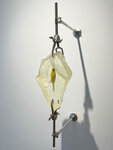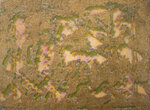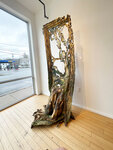Three artists, Hovey Brock, Daniella Dooling and Valerie Hegarty, examine damage done by environmental change, creating a platform for dialogue in an exhibit at Catskill Art Space (CAS) in Livingston …
This item is available in full to subscribers.
Please log in to continue |



Three artists, Hovey Brock, Daniella Dooling and Valerie Hegarty, examine damage done by environmental change, creating a platform for dialogue in an exhibit at Catskill Art Space (CAS) in Livingston Manor, running from March 2 to April 27.
There will be an Earth Day-inspired symposia on the artists’ practices and how they relate to the climate crisis on April 27 at 4 p.m. The Catskill Art Space is located at 48 Main Street, Livingston Manor, NY.
Exhibition hours are Fri. & Sat. 11a.m. - 5 p.m. and Sunday 11 a.m. - 3 p.m. Contact: Instagram: @catskillartspace or sally@catskillartspace.org.
Hovey Brock’s “Crazy River” brings awareness to the unfolding climate crisis, especially in Frost Valley and the west branch of the Neversink River. His installation of paintings on panels and “flags” are created with plastic mesh and scraped acrylic paint over barely decipherable phrases related to the climate crisis, such as “Invasive Species” and “The Woods Are Stressed.”
Environmental turbulence and growing heat are reflected by the use of florid colors.
Brock’s “A Golden Spike for the Anthropocene” is a representation of his experience of two back-to-back floods that devastated the river valley where he lived. It was then that he realized that he was living in the new era called “The Anthropocene”, when climate change “is having an impact on the planet to such a degree that it is showing up in the geological record.” An example of this is the preservation of plastic in the environment that becomes part of that record.
He began the “Crazy River” series in 2017, after a five year transition from formal painting issues to advocating for the problem of climate change. The name is a rough translation of the Lenape term which was anglicized to “Neversink”. He states, “‘Crazy River’ also refers to how turbulent my emotions felt when (faced with) the immediacy of the climate crisis on a personal level.”
Daniella Dooling makes a statement about global animal extinction caused by human behavior in her display of fossilized canaries, which is manifested in “The Canary Project.” Known for their sensitivity to carbon monoxide, canaries were kept by miners as a “risk predictor,” thus the expression “canary in a coal mine” which means that a catastrophe is nearby.
Exploitation of canaries by humans poses an odd relationship: used in mining as well as keeping them caged for the benefit of the enjoyment of their song. The artist does not condone breeding of birds in captivity and uses canaries to honor their lives and reveal the relationship between humans and global animal extinction. The relationship exhibiting the brutality of humans towards other living beings, is causing birds to be the largest species going extinct due to climate change, machines, and man-made structures.
Valerie Hegarty makes a macropolitical statement about the environmental crisis through the lens of colonialism in her large-scale installation “Overseas: Fireplace With Harpoons”. It features a federal-style fireplace, which she built of foamcore and papier-mache, and modeled from a book of period rooms in The Metropolitan Museum of Art. Here, the fireplace becomes an extension of a frame of a painting. The viewer is placed inside a colonialist interior, looking out at icebergs (a replica of a painting), with ideas of exploration, conquest, and aggression towards an exoticized landscape.
The harpoon symbolizes a paintbrush hitting the center of the iceberg, in the context of the ideology of manifest destiny embedded in Early American landscape paintings. The thrust of the harpoon unleashes water, silt, and sand. To complete the representation, a seagull lands on the mantle, symbolizing colonialist aggression that exploits the landscape and causes environmental degradation.
Her work evolved from early large-scale domestic interiors made with glued painted paper on gallery walls and floors, and in later works, to references to art history in versions of famous paintings and sculptures that appear as if they’d undergone transformation through events such as being shot by bullets, pecked by birds, or growing into a tree. She also writes memoirs and fiction to parallel her artwork and has been published.
by The New England Review.
Comments
No comments on this item Please log in to comment by clicking here